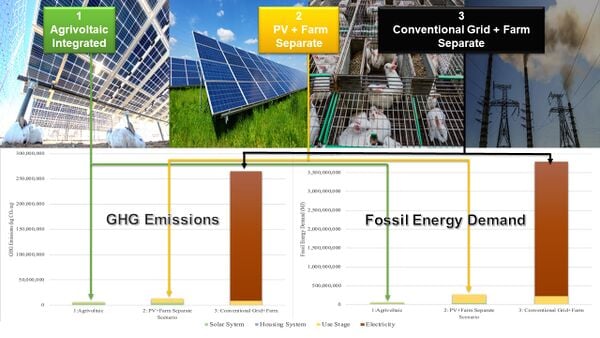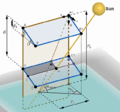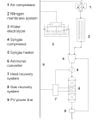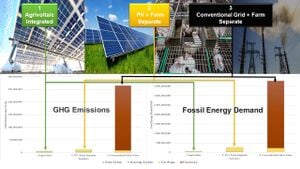
Agrivoltaic systems, which deliberately maximize the utility of a single parcel of land for both solar photovoltaic (PV) electricity production and agriculture, have been demonstrated as a viable technology that can ameliorate competing land uses and meet growing energy and food demands efficiently. The goal of this study is to assess the environmental impacts of a novel pasture-based agrivoltaic concept: co-farming rabbits and solar PV. A life cycle assessment (LCA) quantified the impacts of 1) the integrated agrivoltaic concept in comparison to conventional practices including 2) separate rabbit farming and PV production and 3) separate rabbit farming and conventional electricity production. The impact assessment methods employed to determine the environmental impacts were IPCC 2013 global warming potential 100a V1.03 and fossil energy demand V1.11. The results indicate that the pasture-based agrivoltaic system produces the least amount of greenhouse gas emissions (3.8 million kg CO₂ equivalent) and demands the least amount of fossil energy (46 million MJ) per functional unit of cumulative MWh output of electricity and cumulative kg of meat over 30 years in comparison to the two other scenarios under study. The pasture-based agrivoltaic system features a dual synergy that consequently produces 69.3 % less emissions and demands 82.9 % less fossil energy compared to non-integrated production. The potential for agrivoltaic systems to significantly reduce environmental impacts revealed by this LCA demonstrates that integrated solar and pasture-based agricultural systems are superior to conventional practices in terms of their comparatively lower emission and energy intensity. These findings provide empirical support for increased agrivoltaic system development more broadly.
Highlights[edit | edit source]
- Life cycle assessment of pasture-based agrivoltaic system limited to emissions and fossil energy.
- Comparison between 3 scenarios show agrivoltaics is superior to conventional practice.
- CO₂ emissions and fossil energy demand were quantified for rabbit agrivoltaic system.
- Integrated production results in 69.3 % less emissions and 82.9 % less energy demand.
In the Media[edit | edit source]
- How "Agrivoltaics" Can Provide More Benefits Than Agriculture And Solar Photovoltaics Separately Energy Innovation
See also[edit | edit source]
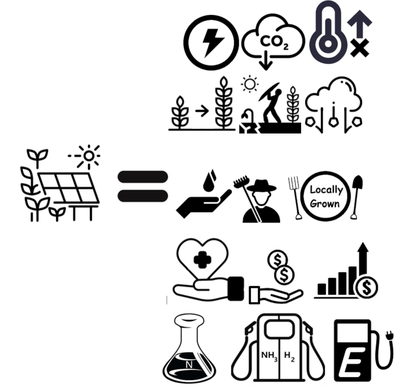
- Coal with Carbon Capture and Sequestration is not as Land Use Efficient as Solar Photovoltaic Technology for Climate Neutral Electricity Production
- Dual use of land for PV farms and agriculture literature review
- sheep
- Israeli white plastic reflectors
- A Farmer's Guide to Going Solar (NREL)
- German guidelines: https://www.ise.fraunhofer.de/content/dam/ise/en/documents/publications/studies/APV-Guideline.pdf
- 2021 review
- Miskin, C.K., Li, Y., Perna, A., Ellis, R.G., Grubbs, E.K., Bermel, P. and Agrawal, R., 2019. Sustainable co-production of food and solar power to relax land-use constraints. Nature Sustainability, 2(10), pp.972-980.
- Retrofitting solar parks for agrivoltaics
- Shading PV
- Alexis' talk at American Solar Grazing Association2021
In the News[edit source]
- Agrivoltaics: solar energy + better crops Climate and Nature
- Why solar power and farmers’ fields could be the perfect combination TVO
- Solar farms and sheep show the makings of a clean energy classic duo Business Renewables
- Agrivoltaics charge up St. Albert-area farms St Albert Gazette
- Sheep, solar and crops. How some Alberta farms are creating ideal growing conditions Western Wheel
- Sheep, solar and crops. How some Alberta farms create ideal growing conditions Voxpopuli
- Protein bars from recycled plastic bottles? An indoor farm on wheels? Western prof gets innovative with green tech Toronto Star
- 加拿大环保狂人回收塑料瓶制成蛋白棒 还有可移动室内农场!? Lahoo





